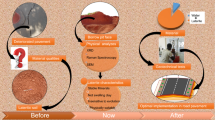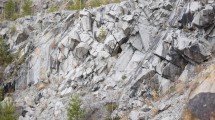Abstract
Laterite profiles developed from granite in southwestern Australia were studied by scanning electron microscopy. The morphology of soil materials reflects the mineralogy of secondary minerals formed from feldspar. In the saprolite, etched feldspar surfaces are coated with kaolinite or radiating, spherical aggregates of tubular halloysite. In the lower pallid zone these minerals have replaced most of the feldspar. In the upper pallid zone a porous framework has developed consisting mainly of quartz and gibbsite with 5-/μm euhedral gibbsite crystals in voids. Halloysite crystals in the upper pallid zone are partly unrolled and have splayed ends. Differences in mineralogy and morphology between profiles are thought to be due to variations in the intensity of leaching.
Резюме
С помощью электронного сканирующего микроскопа изучались латеритные разрезы, развившиеся в результате выветривания гранита в юго-западной Австралии. Морфология почвенных материалов отражает минералогию вторичных минералов, образованных из полевого шпата. В сапролите, выветрелые поверхности полевого шпата покрыты каолинитом или лучевыми, сферическими агрегатами трубчатого галлуазита. В нижней, паллидной зоне эти минералы почти полностью заместили полевой шпат. В верхней паллидной зоне образовалась пористая структура, состоящая в основном из кварца и гиббсита с 5 μм идиоморфными кристаллами гиббсита в полостях. Галлуазитовые кристаллы в верхних паллидных зонах частично развернуты и имеют скошенные концы. Различия в минералогии и морфологии разрезов объясняется изменением интенсивности выщелачивания. [N. R.]
Resümee
Lateritprofile, die sich im südwestlichen Australien im Granit gebildet haben, wurden mittels Rasterelektronenmikroskopie untersucht. Die Morphologie des Bodenmaterials zeigt die Mineralogie der Sekundärminerale, die sich aus Feldspat gebildet haben. Im Rückstandsgestein sind geätzte Feldspatoberflächen mit Kaolinit oder radial strahligen Aggregaten aus röhrenförmigem Halloysit überzogen. In der tieferen bleichen Zone haben diese Minerale fast den ganzen Feldspat ersetzt. In der oberen bleichen Zone hat sich ein poröses Gerüst gebildet, das hauptsächlich aus Quarz und Gibbsit besteht, mit 5 μm großen idiomorphen Gibbsitkristallen in den Hohlräumen. Die Halloysitkristalle in der oberen bleichen Zone sind teilweise entrollt und haben nach außen gebogene Enden. Die Unterschiede in der Mineralogie und Morphologie der einzelnen Profile werden auf eine verschieden starke Auslaugung zurückgeführt. [U. W.]
Résumé
Des proflies de latérite développés à partir de granite en Australie du sud ouest ont été étudiés par microscopie électronique balayante. La morphologie des matériaux du sol réflète la minéralogie des minéraux secondaires formés à partir de feldspar. Dans la saprolite, des surfaces de feldspar gravées sont recouvertes de kaolinite ou d’aggrégats sphériques et branchants d’halloysite tabulaire. Dans la zone inférieure pâle, ces minéraux ont remplacé la plupart des feldspars. Dans la zone pâle supérieure, une charpente poreuse s’est développée consistant surtout de quartz et de gibbsite avec des cristaux euhédraux de 5μm de gibbsite dans les vides. Les cristaux d’halloysite dans la zone pâle supérieure sont partiellement déroulés et ont des bouts ébrasés. On croit que les différences de minéralogie et de morphologie entre les profiles sont dues à des variations dans l’intensité du lessivage. [D. J.]
Similar content being viewed by others
References
Bardossy, G., Csanady, A., and Csordas, A. (1978) Scanning electron microscope study of bauxites of different ages and origins: Clays & Clay Minerals 26, 245–262.
Diamond, S. and Bloor, J. W. (1970) Globular cluster micro-structure and endellite (hydrated halloysite) from Bedford, Indiana: Clays & Clay Minerals 18, 309–312.
Eswaran, H. and Bin, W. C. (1978a) A study of a deep-weathering profile on granite in peninsular Malaysia. I. Physico-chemical and micromorphological properties. Soil Sci. Soc. Amer. J. 42, 144–149.
Eswaran, H. and Bin, W. C. (1978b) A study of a deep-weathering profile on granite in Peninsular Malaysia. III. Alteration of feldspars. Soil Sci. Soc. Amer. J. 42, 154–158.
Eswaran, H., Stoops, G., and Sys, C. (1977) The micromorphology of gibbsite forms in soils: J. Soil Sci. 28, 136–143.
Gilkes, R. J., Scholz, G., and Dimmock, G. M. (1973) Lat-eritic deep-weathering of granite: J. Soil Sci. 24, 523–536.
Gilkes, R. J. and Suddhiprakarn, A. (1979a) Magnetite alteration in deeply-weathered adamellite: J. Soil Sci. (in press).
Gilkes, R.J. and Suddhiprakarn, A. (1979b) Biotite alteration in deeply weathered granite. I. Morphological, mineralogi-cal and chemical properties: Clays & Clay Minerals 27, 349–360.
Grubb, P. L. C. (1971) Mineralogical anomalies in the Darling Ranges bauxites at Jarrahdale, Western Australia: Econ. Geol. 66, 1005–1016.
Herbert, E. J., Shea, S.R., and Hatch, A.B. (1978) Salt content of lateritic profiles in the Yarragil Catchment, Western Australia: West Australian Forest Department Research Paper No. 32, 8 pp.
Hsu, P. H. (1977) Aluminum hydroxides and oxyhydroxides: in Minerals in Soil Environments, J. B. Dixon and S. B. Weed, eds., Soil Sci. Soc. Amer., Madison, Wisconsin, 99–143.
Keller, W. D. (1976) Scan electron micrographs of kaolins collected from diverse environments of origin: Clays & Clay Minerals 24, 107–113.
Keller, W. D. (1977) Scan electron micrographs of kaolins collected from diverse environments of origin. IV. Georgia kaolin and kaolinizing source rocks: Clays & Clay Minerals 25, 311–345.
Krinsley, D. H. and Doornkamp, J. C. (1973) Atlas of Quartz Sand Surface Textures: University Press, Cambridge, 91 pp.
Little, I. P., Armitage, T. M., and Gilkes, R. J. (1978) The weathering of quartz in dune sands under sub-tropical conditions in southeastern Australia: Geoderma 20, 225–237.
Sadleir, S.B. and Gilkes, R.J. (1976) Development of bauxite in relation to parent material near Jarrahdale, Western Australia: J. Geol. Soc. Aust. 23, 333–344.
Author information
Authors and Affiliations
Rights and permissions
About this article
Cite this article
Gilkes, R.J., Suddhiprakarn, A. & Armitage, T.M. Scanning Electron Microscope Morphology of Deeply Weathered Granite. Clays Clay Miner. 28, 29–34 (1980). https://doi.org/10.1346/CCMN.1980.0280104
Received:
Accepted:
Published:
Issue Date:
DOI: https://doi.org/10.1346/CCMN.1980.0280104




